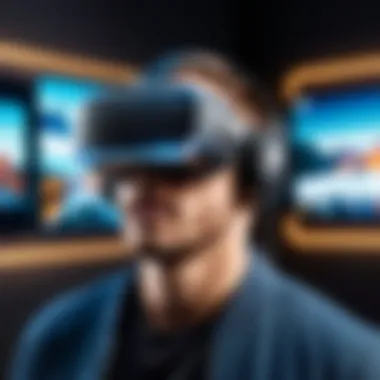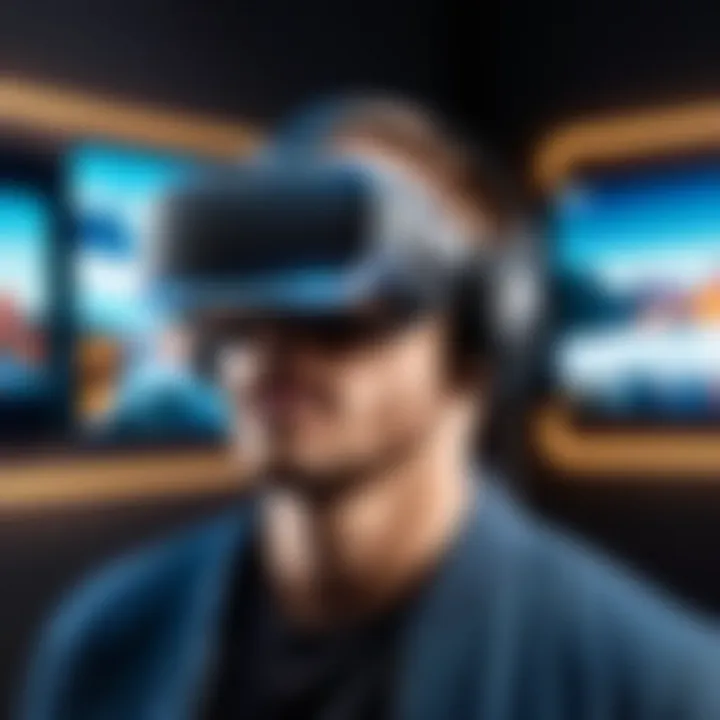Exploring the Link Between Tech, Entertainment, and Design


Intro
The synergy between technology, entertainment, and design pulses at the heart of modern culture. Each field not only flourishes within its own realm but also profoundly influences the others, creating a web of interdependence that shapes consumer behaviors and expectations. In this exploration, we will unpack how these three domains braid together in various ways, from technological innovations reshaping entertainment experiences to design principles that enhance our daily interactions with tech products.
In a world where instantaneous access to content is the norm, understanding this intersection becomes crucial. It allows us to grasp how trends are born and evolve, and why certain developments in one area can cause ripples across the others. This article will also reflect on current movements within these fields, spotlighting significant advancements and noteworthy future directions.
So, fasten your seatbelt; we are about to delve into the intricate tapestry woven by technology, entertainment, and design, revealing insights relevant to anyone keen on the dynamics driving today's creative landscape.
Prelude to the Convergence of Fields
In the age of rapid technological advancement, where even the most entrenched ideas appear to be shifting sand, understanding the convergence of technology, entertainment, and design is crucial. These areas, once seen as distinct realms, have begun to weave together in a way that significantly impacts industries, consumer habits, and cultural narratives. Their interplay not only shapes user experiences but also pushes the boundaries of creativity and innovation.
The importance of examining this interconnection lies in its ability to reveal underlying trends and shifts in consumer expectations. For instance, a tech-savvy audience—hungry for immersive experiences—demands that entertainment mediums evolve not only visually but also functionally. Gone are the days when design was merely aesthetic; now, it serves a pivotal role in enhancing functionality and shaping user interactions. This phenomenon is particularly pronounced in the realms of gaming and virtual reality, where seamless integration of user-friendly design translates directly into user satisfaction and retention.
Benefits of exploring this convergence include:
- Enhanced User Engagement: As technology facilitates new forms of entertainment, designing for enriched user experiences becomes vital.
- Innovation in Creativity: Merging tech prowess with artistic insight leads to groundbreaking products that can redefine industries.
- Informed Consumer Choices: An understanding of how these fields influence one another can equip consumers with better decisions, as they gauge the technological implications behind design and content.
Moreover, there are unique considerations we must entertain. As technology evolves, our ethical responsibilities concerning design and content creation also shift. How do we create inclusive experiences in entertainment, especially in an era of sensitivity around representation and diversity? This question looms large and deserves deep reflection.
In this piece, we will delve into the multifaceted influences of technology, entertainment, and design, recognizing their combined effect on modern culture. Tackling each area will provide a broader understanding of how they simultaneously shape our digital landscape and everyday lives.
Defining Technology, Entertainment, and Design
To grasp the nuances of this intersection, we must first delineate what constitutes technology, entertainment, and design in a contemporary context.
- Technology: Often defined as the application of scientific knowledge for practical purposes, in this discourse, technology encompasses everything from advanced computing systems to the simple algorithms that enable functionality in apps we use daily.
- Entertainment: This has evolved beyond traditional mediums like film and music. It now includes practices through video games, streaming services, and interactive media that engage audiences in unprecedented ways.
- Design: Design can be perceived as the blueprint that governs how technology and entertainment function together. It spans graphical layout, product usability, and storytelling through visuals. Good design reinforces a seamless experience, ensuring both accessibility and enjoyment.
Together, these definitions set the stage for understanding their convergence, leading to richer and more holistic consumer experiences.
Historical Context: Evolution Over Time
To appreciate the current landscape we see today, it is essential to reflect on the historical context that has shaped these fields. The evolution is nothing short of a tapestry weaving together technological breakthroughs, artistic movements, and consumer demands over decades.
From the inception of film as a novel entertainment medium in the early 20th century to the disruptive launch of streaming services like Netflix, we see a clear trajectory of technological change driving shifts in entertainment.
Key milestones might include:
- The Advent of Television: Transforming how people consumed stories and information, it also marked the beginning of design considerations impacting screen interfaces.
- The Rise of Personal Computers: This shift introduced new forms of interaction and user-experience design tailored to allow broader access to various entertainment forms.
- The Internet Revolution: It significantly altered the dynamics of content creation and consumption, giving rise to new design trends like responsive web design, catering to the expanding variety of devices.
Such historical insights are vital in understanding how imperative it is for these domains to engage with one another actively. As we look ahead, we can anticipate how past experiences will shape future innovations and consumer behavior.
The Role of Technology in Entertainment
Technology has become a cornerstone in the entertainment industry, reshaping how we consume, engage, and interact with various forms of media. The impact is not just about innovations but creating a profound shift in our expectations around accessibility, personalization, and immersion. For this article, understanding the role of technology in entertainment is crucial as it depicts how these advancements significantly enhance user engagement and enrich storytelling methods.
Emerging Technologies Transforming Media
Virtual Reality
Virtual reality (VR) has emerged as a powerful medium that redefines user experiences by transporting individuals to immersive environments. The key characteristic of VR is its ability to simulate real-world scenarios, effectively blurring the line between fiction and reality. This technology finds its footing in gaming and interactive experiences, leading to a surge in gamer enthusiasm and participation. One of the unique features of VR is its capacity for creating environments that respond in real-time to user actions, adding an element of realism that traditional media cannot match. However, there are drawbacks, such as the high cost of equipment and the potential for user motion sickness, which can limit its widespread adoption. Nevertheless, the allure of fully immersive tales can be a game changer in how stories are told.


Artificial Intelligence
Artificial intelligence (AI) reshapes the landscape of content creation and personalization within the entertainment sector. The key characteristic of AI is its ability to analyze and predict consumer preferences, allowing platforms to tailor content to individual users. This personalized approach enhances viewer satisfaction, fostering deeper connections to the content being consumed. A significant unique feature of AI is its role in automating processes, from script generation to editing, enhancing efficiency in production. While the rapid incorporation of AI may raise concerns regarding originality and creativity, it undeniably opens new avenues for innovation in storytelling and production responsiveness.
Streaming Services
Streaming services have revolutionized access to entertainment by making a vast array of content available at the touch of a button. The key characteristic here is the flexibility and convenience they offer, allowing individuals to watch what they want, when they want, without the constraints of traditional broadcasting times. Streaming platforms often provide a unique feature in that they can curate recommendations based on viewer habits, which can introduce users to content they might not have discovered otherwise. However, this has brought about the so-called “content overload,” where audiences may feel overwhelmed by choices. Striking a balance between quality and quantity remains paramount for these platforms.
Impact on Content Creation and Distribution
The advancement of technology has not only impacted how content is consumed but also fundamentally altered the dynamics of creation and distribution.
- Accessibility: Today’s creators can produce high-quality content using accessible tools and platforms, democratizing the environment for budding talents.
- Platform Diversity: With various mediums—YouTube, TikTok, and social media channels—emerging, content creators can share their work with audiences worldwide, regardless of traditional gatekeeping standards.
- Engagement through Interactivity: New formats encourage audience participation, especially in gaming and live interactive formats, which enhance viewer engagement and loyalty.
The evolving landscape of technology in entertainment presents both challenges and opportunities for creators and consumers alike. As these tools continue to develop, they not only shape the experiences we cherish but also cultivate a culture that reflects our collective aspirations and innovations.
Design's Influence on Technological Innovation
Design plays a pivotal role in shaping technological innovation. It acts as the bridge that connects functionality with aesthetics, delivering solutions that resonate with users on both practical and emotional levels. This dual influence is not only vital in enhancing user experiences but also in driving technological advancements. In today’s fast-paced world, where attention spans are shorter than a blink of an eye, good design can mean the difference between a product that captures interest and one that fades into obscurity.
One of the major benefits of integrating design into technology is the enhancement of usability. When products are designed with the user in mind, they naturally cater to the needs and preferences of the end user. This principle of user-centric design ensures that technological innovations are approachable and engaging, promoting a more meaningful interaction.
By employing design thinking, companies can pinpoint pain points in existing solutions and create intuitive interfaces, which simplify complex technology. For instance, the rise of mobile applications that require minimal navigation complexity showcases how design can help consumers adapt quickly to new technologies.
Moreover, attractive design can drive consumer demand. People often gravitate towards products that look good. A well-designed product not only catches the eye but also suggests quality and functionality. In a market saturated with similar options, design serves as a distinguishing element. This can ultimately influence purchasing decisions and brand loyalty, showcasing the indirect economic benefits derived from strong design principles.
User-Centric Design Principles
User-centric design principles are at the core of effective technological innovation. This approach emphasizes the importance of understanding user behaviors, needs, and motivations. Utilizing techniques like user research, personas, and usability testing enables designers to tailor technologies to better align with their audience's expectations.
A few key aspects include:
- Empathy: Understanding the user's perspective is crucial. This involves immersing oneself in the user's experience and identifying pain points to enhance the overall usability.
- Iterative Design: The process of creating and refining designs based on user feedback helps in continuously improving the product. This responsiveness is vital in keeping pace with evolving user needs.
- Accessibility: A great design accommodates a diverse range of users, including those with disabilities. Prioritizing inclusivity leads to a wider user base and increases engagement.
With these principles, companies are positioned to develop technologies that not only meet market demands but also foster a loyal user community.
Case Studies in Successful Design Integration
Iconic Tech Products
Every now and then, a tech product arrives that doesn't just push the envelope but flips it inside out entirely. Take Apple’s iPhone as a prime example. Its sleek design, intuitive interface, and seamless integration of hardware and software made it a revolutionary product in the smartphone market. The easy-to-use touch interface and minimalist aesthetics set the standard for what users expect from mobile technology today.
The key characteristic of the iPhone is its ability to blend functionality with style, making it not just a gadget but a fashion statement. This has significantly contributed to Apple’s brand identity as a leader in design-driven technology.
Additionally, its unique feature—an extensive ecosystem of apps—enables users to personalize their devices immensely. This adaptability seems to resonate well with consumers, inviting them to engage deeply with the product, ultimately solidifying Apple’s hold in the marketplace.
However, while its premium design comes with many advantages—like brand prestige and user satisfaction—there’s always a trade-off. The high price point can deter some potential buyers, which is a consideration for companies looking to penetrate competitive markets.
Design-Driven Companies
Another compelling narrative is that of design-driven companies like Tesla. Tesla’s emphasis on design is not merely aesthetic; it is foundational to its technological innovations. Their electric vehicles are not just products; they represent a vision of sustainable technology that prioritizes both performance and environmental consciousness.
The characteristic that stands out the most is how Tesla integrates cutting-edge design with advanced technology. Their cars boast unique interfaces, luxurious interiors, and self-driving capabilities. This makes driving not just a necessity but an experience rather than an obligation.


On the flip side, the sleek design and high-tech features come with high costs, creating a barrier for many potential buyers. Nonetheless, for those that can afford it, the allure of innovative design aligned with sustainability is a compelling factor that contributes to brand loyalty and consumer pride.
Cultural Interconnectivity of Entertainment and Design
Understanding cultural interconnectivity in the realms of entertainment and design isn't just a nice-to-have; it's a necessity in today’s vibrant landscape. The ways in which these domains influence one another reflect broader societal values and ongoing changes in consumer behavior. The seamless blending of design aesthetics into entertainment mediums enhances user experience, while the stories and representations in media magnify cultural narratives. This relationship, much like a well-choreographed dance, showcases how intricately linked these fields are, benefiting audiences, creators, and industries alike.
Representation and Diversity in Media
Diversity and representation in media have gained prominence, shaping the way audiences connect with content. When films or shows feature a varied tapestry of characters and stories, they invite viewers to see their own experiences reflected back at them. This representation fosters inclusivity and respect, allowing marginalized voices to gain visibility and recognition.
Take the rise of streaming services such as Netflix or Amazon Prime, which have allowed for a broader range of narratives to flourish. For instance, the success of shows like "Crazy Rich Asians" or "Black Panther" highlights how crucial representation is in justifying the investment in diverse storytelling.
In addition, cultural representation stretches beyond just the storyline. Design choices, from costume to set design, also play a significant role in conveying authenticity. By drawing on cultural motifs and styles, designers bring stories to life in ways that resonate deeply with audiences. This makes it essential for both creators and designers to collaborate closely, ensuring that media narratives honor the very cultures they represent.
"Diversity isn’t just a trend; it’s a mirror reflecting society’s myriad stories that deserve to be told."
The Role of Aesthetics in Popular Culture
Aesthetics serve as a bridge in fostering connections between audiences and the content they consume. As trends evolve, the visual appeal of entertainment—whether through film, gaming, or interactive media—creates emotional resonance. The old adage that "we eat with our eyes first" rings true here. The design choices made in production greatly influence viewers' engagement.
For example, think about how colorful and innovative sets in films like "La La Land" or the distinct visual style in animated hits like "Spider-Man: Into the Spider-Verse" set the tone. The aesthetics of these products aren’t merely an accessory; they play a key role in shaping the viewer's perception.
Moreover, as technology such as augmented reality becomes more mainstream, the aesthetics in design become even more crucial in influencing popular culture. They are creating experiences that go beyond passive consumption, allowing audiences to immerse themselves in narratives. Surrealistic designs or breathtaking graphics can elevate stories to new heights.
In summary, the synergy between entertainment and design is not just about the product but about the entire experience it offers. As the cultural landscape continues to shift, understanding these interconnections will be paramount in navigating the complexities of modern consumer culture.
Future Trends and Predictions
As we look ahead in the intersection of technology, entertainment, and design, several trends surface that could be game-changers. These trends are significant not because they are flashy, but due to their potential to reshape consumer experiences and redefine industry standards. A forward-thinking approach is required, acknowledging that the evolving landscape demands adaptability.
Evolving Consumer Behaviors
Today's consumers are unlike those of a decade ago. This transformation is not merely a shift in preferences but reflects deeper, underlying changes in values and lifestyle. People are now looking for personalized and immersive experiences. They don't just want to consume content; they desire to interact with it, to be part of it.
For instance, streaming services have moved beyond simple menus; they now curate content based on viewing habits and preferences. This reflects a growing inclination toward tailored experiences. The demand for interactivity has sparked a rise in platforms that allow users to engage directly with creators, blurring the lines between consumer and producer.
- Personalization: Algorithms that understand user preferences better each day.
- Interactivity: Immersive environments where users feel part of the content.
- Sustainability: Increased awareness about the environmental impact of consumer behavior.
This complex tapestry is further woven with social media dynamics where influencer culture directly affects purchasing choices. Consumers follow their favorite figures on platforms like Instagram and TikTok, not only for entertainment but also for recommendations that shape their shopping behaviors.
Technological Advancements on the Horizon
The future is ripe with innovations, especially in areas like quantum computing and augmented reality.
Quantum Computing
Quantum computing stands as a beacon of potential in the tech world. Its essence lies in harnessing the strange behaviors of quantum bits to perform calculations at unrivaled speeds. This contributes significantly to problem-solving across various domains, including cryptographic security and massive data analysis. One key characteristic of quantum computing is its ability to run numerous calculations simultaneously, compared to classical computers that operate sequentially.
- Unique Feature: The principle of superposition allows for multiple states at once, significantly enhancing computational power.
- Advantages: Potential breakthroughs in drug discovery, materials science, and complex computational problems that were previously thought impossible.
- Disadvantages: High costs and technological hurdles still linger, making it a challenging prospect even for leading firms.
Augmented Reality


Augmented reality (AR) is another frontier shaping up to redefine user interactions with digital content. Unlike virtual reality that immerses users in a completely different world, AR overlays digital information onto the real world. This characteristic makes it a beneficial choice for enhancing user experiences without removing physical surroundings.
- Unique Feature: The ability to combine real-world and digital elements in real-time opens new engagement levels.
- Advantages: Businesses can implement AR for training and marketing, enhancing product demonstrations and engagement.
- Disadvantages: There are technical limitations and accessibility issues that can hinder widespread adoption.
"As technology evolves, it becomes increasingly intertwined with art and entertainment, creating an intricate web of consumer expectations and experiences."
In summary, the intersection of evolving consumer behaviors and technological advancements like quantum computing and augmented reality paves the way for a dynamic future in the realms of technology, entertainment, and design. Companies that understand and embrace these trends will not only stay relevant but also lead the way in shaping culture.
The Interplay of Social Media and Content Creation
In today's digital age, the interplay between social media and content creation has turned into a significant force shaping technology and entertainment. It's no longer just about consuming content—creation, sharing, and interacting have risen to the forefront. Social media platforms are not only avenues for entertainment but also a breeding ground for innovation, as creators and consumers alike engage in a symbiotic relationship. This relationship influences both design and technology, setting new trends in how we communicate and interact with information.
Social media serves as a launchpad for diverse expressions of creativity while simultaneously reshaping the design philosophy behind many tech products. As a result, understanding this intersection becomes crucial for both creators and companies vying to capture attention in a saturated market. The benefits and considerations surrounding this relationship are varied and compelling.
"Social media is not just a platform for sharing; it’s a catalyst for cultural shifts and technological advancements."
Influencer Culture's Impact on Design and Technology
The rise of influencers as vital players in the content creation landscape cannot be overstated. Influencers, who often operate on platforms like Instagram, TikTok, and YouTube, have enormous power to shape public opinions and trends, particularly among younger audiences. Their recommendations can make or break product launches and drive engagement with new technologies.
- Authenticity Over Perfect: Influencers often opt for authenticity, showcasing products and tech in real-world scenarios. Their genuine endorsements can lead consumers to expect a more user-feel driven interface and aesthetic. This idea that 'real people' use a design can enhance trust and relatability.
- Feedback Loop: Influencers frequently engage with their audiences, which can create a feedback loop that informs designers and tech innovators about what features or aesthetics resonate well with users. The direct interaction allows for real-time adjustments, ensuring that products are not only relevant but also desirable.
- Visual Design Trends: Aesthetic preferences pushed by influencer culture often lead to trends in digital design. Bright colors, minimalism, or engaging animations can be influenced heavily by what resonates on social media, so designers must keep their fingers on the pulse to remain competitive.
The Role of User-Generated Content
User-generated content has become a bedrock of the social media landscape. Everyday users are not just passive consumers but active content creators, impacting how brands design products. This elevates the content creation narrative in several important ways:
- Community Engagement: Platforms like Reddit and Facebook have curated communities where users discuss and share experiences about tech products. Such interactions foster a sense of community around these brands and products, creating a richer narrative than any single advertisement could.
- Savvy Consumers: Today’s audience is more discerning than ever. Armed with information from fellow users, they expect brands to address their needs and preferences transparently. This creates pressure on designers and tech companies to deliver not only quality but also value that aligns with community feedback.
- Diverse Perspectives: User-generated content offers a kaleidoscope of viewpoints. Whether through reviews, videos, or art, diversity in perspectives inspires innovation in product design and technology, ensuring that different user needs are met.
Ending: The Synergy of Technology, Entertainment, and Design
In today’s world, the convergence of technology, entertainment, and design isn’t just a pleasant surprise; it’s a necessity for businesses and creators alike. The intricate dance between these three domains fosters innovation and shapes audience engagement in ways previously thought impossible. A closer examination of this synergy reveals its profound benefits.
One important aspect is how technology enhances entertainment experiences. With the rise of high-definition streaming services and interactive platforms, audiences expect content that is not only immersive but also tailored to their tastes. This demand drives designers to create interfaces that are both aesthetically pleasing and user-friendly. For instance, consider the sleek, intuitive layout of platforms like Netflix or Apple Music. Their designs invite users into an ecosystem that seamlessly blends visual appeal with functionality.
"The magic happens where technology meets creativity—because innovation isn’t just about new gadgets, it’s about new ideas."
Moreover, the integration of design in technology leads to products and services that resonate on an emotional level with consumers. Take Apple, for example, whose commitment to design has set a benchmark in the tech industry. Each device—from the iPhone to the MacBook—reflects a careful attention to detail that appeals not just through function but through an emotional connection. People don’t just buy Apple products; they buy into a lifestyle.
The current landscape also showcases how technology serves as a democratizing force in entertainment. Social media platforms like TikTok and Instagram allow creators to launch their content without traditional gatekeeping methods. This emergence encourages a wider variety of voices and styles in the entertainment industry, changing what audiences consume and how they interact with it.
Reflecting on the Current Landscape
Addressing the present state of affairs in technology, entertainment, and design is crucial for better understanding the ongoing evolution of these industries. Today, technology acts as a bridge linking creators with audiences, introducing formats such as interactive storytelling and immersive environments.
Current trends show that virtual reality tools are redefining how stories are told, creating all-encompassing worlds that draw audiences into experiences. Shows like Bandersnatch on Netflix exemplify how viewer choice intersects with narrative. This cross-pollination leads designers to embrace more innovative ways to engage audiences.
Furthermore, cultural representation is profoundly shaped by these interactions, as designers ensure diverse narratives are not merely an afterthought but embedded in the content creation process. As seen with various streaming platforms investing in international films and series, the focus on diversity is paving pathways for richer storytelling.
Future Directions and Opportunities
As we look forward, the areas of technology, entertainment, and design continue to expand and evolve at a staggering pace. Emerging technologies promise even deeper integration, with advancements like artificial intelligence and augmented reality presenting new opportunities for creators.
For instance, as AI develops, we might see more personalized entertainment options tailored specifically to an individual’s viewing habits. This could take the form of unique story arcs that evolve based on user choices, as seen in early prototypes of interactive storytelling.
AR has the potential to merge real-world experiences with digital overlays, blurring the lines between the physical and virtual worlds. Imagine attending a live concert where, through AR glasses, audience members can visualize additional set pieces or interact with layered content in real-time. The interaction of these technologies offers a glimpse into a future rich with exploration and creativity.
With the continual rise of creator-led platforms and decentralized media, we can anticipate a shift in how content is valued and monetized. The barriers of entry are diminishing, giving rise to new creators who leverage these advancements to express ideas previously locked behind those gates.
In summary, the synergy of technology, entertainment, and design is not just about creating visually captivating experiences or appealing interfaces; it’s the soul of innovation that poses questions, provokes thought, and challenges norms, while simultaneously encouraging an inclusive, consumer-focused landscape.







